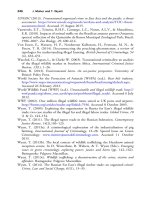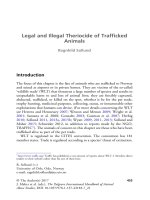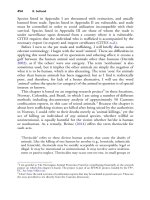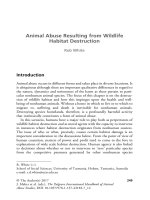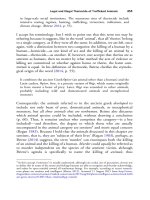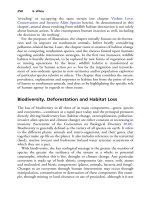The palgrave international handbook of a 21
Bạn đang xem bản rút gọn của tài liệu. Xem và tải ngay bản đầy đủ của tài liệu tại đây (25.66 KB, 1 trang )
8
J. Maher et al.
chapters to this volume. By design, we encouraged a multidisciplinary
focus—conjoining lawyers, animal welfare/rights practitioners and journalists with academics—to discuss a particular type of animal abuse,
writing, where possible, from a research-based and/or practitioner perspective. While the book was constructed with criminology and related
subjects in mind, the selection of topics and construction of the book
was deliberately chosen to make it accessible to a wide range of academic
disciplines—including law, human–animal studies, forensics and environmental studies. It is our hope that this collaborative multidisciplinary
approach opens new horizons and that it will enable new approaches to
the understanding and prevention of animal abuse.
This Introduction sheds light on key issues in animal abuse studies. The
Handbook has seven Parts. Chapter 1 provides an introduction to the book
and to key issues in animal abuse studies. The following parts focus on
specific harms and abuses experienced by animals within each of the areas
identified above. Part I contains six chapters which redefine the abuse of
domesticated animals. These chapters suggest that because domestic animals
are wards under our control, they should receive an appropriate level of care
and protection. That said, their closeness exposes them to specific harms,
which are largely consistent with the continuum of abuse experienced in
interpersonal domestic relationships—such as physical and psychological
abuse, sexual abuse, cruelty and neglect. Consequently, ‘the link’ between
animal abuse and interpersonal violence has received widespread recognition
from both animal and human welfare groups, from social care, law, psychiatry, and so on, resulting in some types of animal abuse being recognised as
serious harms and crimes (for example, animal sexual assault and status dogs
ownership) and others as indicative of mental health disorders (for example,
animal hoarding and neglect). However, each chapter highlights the ambivalence inherent in our responses to animal abuse and the importance of
context to understand the motivation for, and problematic responses to,
animal abuse.
Part II presents two accounts of the abuse experienced by animals in farming. The need for a harm-based definition of animal abuse is central to this
discussion. The normative everyday practices of animal food production
collectively result in the most widespread and systematic abuse of animals.
Unlike the abuse of domesticated animals and the intense societal response, the
abuse endemic in the farming of animals is normalised and contributes
mightily to the cultural hegemony of meat production and to the general
subjugation of animals.
